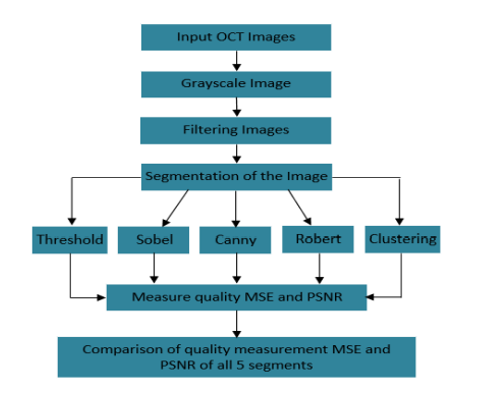Analysis of Various Image Segmentation Techniques on Retinal OCT Images
Objective
The primary objective of this project is to systematically evaluate and compare different image segmentation techniques applied to Retinal Optical Coherence Tomography (OCT) images. This analysis aims to enhance our understanding of the performance and suitability of various segmentation methods for accurately delineating retinal structures and anomalies within OCT images
Abstract
Image segmentation is the process of dividing an image's elements for further processing. This article looked at a number of image segmentation techniques, including the threshold approach, edge-based method, and clustering-based method. The segmentation method that is most effective for separating images in OCT images is clustering-based segmentation.
To reduce the speckle noise during preprocessing, the wiener filter approach is used. With regards to the threshold, edge-based (Sobel, Canny, Robert's), and clustering-based segmentation techniques, calculate MSE (mean square error) and PSNR (peak signal to noise ratio) values for the segmented image quality.
Keywords— Clustering; Edge detection; Image segmentation; Region-based; Threshold
NOTE: Without the concern of our team, please don't submit to the college. This Abstract varies based on student requirements.
Block Diagram

Specifications
Software: Matlab 2020a or above
Hardware:
Operating Systems:
- Windows 10
- Windows 7 Service Pack 1
- Windows Server 2019
- Windows Server 2016
Processors:
Minimum: Any Intel or AMD x86-64 processor
Recommended: Any Intel or AMD x86-64 processor with four logical cores and AVX2 instruction set support
Disk:
Minimum: 2.9 GB of HDD space for MATLAB only, 5-8 GB for a typical installation
Recommended: An SSD is recommended A full installation of all MathWorks products may take up to 29 GB of disk space
RAM:
Minimum: 4 GB
Recommended: 8 GB
Learning Outcomes
· Introduction to Matlab
· What is EISPACK & LINPACK
· How to start with MATLAB
· About Matlab language
· Matlab coding skills
· About tools & libraries
· Application Program Interface in Matlab
· About Matlab desktop
· How to use Matlab editor to create M-Files
· Features of Matlab
· Basics on Matlab
· What is an Image/pixel?
· About image formats
· Introduction to Image Processing
· How digital image is formed
· Importing the image via image acquisition tools
· Analyzing and manipulation of image.
· Phases of image processing:
o Acquisition
o Image enhancement
o Image restoration
o Color image processing
o Image compression
o Morphological processing
o Segmentation etc.,
· How to extend our work to another real time applications
· Project development Skills
o Problem analyzing skills
o Problem solving skills
o Creativity and imaginary skills
o Programming skills
o Deployment
o Testing skills
o Debugging skills
o Project presentation skills
o Thesis writing skills

 Paper Publishing
Paper Publishing
